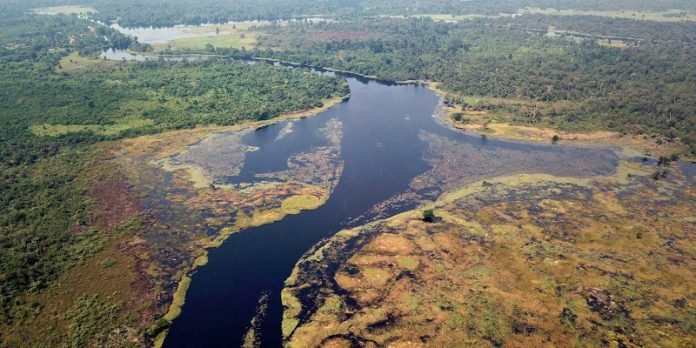
Imagine a river so dark that you can’t even see your hand if you put it into the water.
That’s how dark the Ruki River is.
Located in Africa, the Ruki flows into the massive Congo River and might just be the world’s darkest large river, even darker than the famous Rio Negro in South America’s Amazon.
So, why is the Ruki River this dark? Scientists, like Travis Drake from ETH Zurich, explain that it’s because the river has loads of dissolved organic material, which gives the water its pitch-black appearance. Think of it as a giant pot of “jungle tea.”
When rain falls on the nearby jungle, it washes over dead plants, soaking up organic substances and carrying them into the river.
And since the river often floods the forest during heavy rain, the water spends a lot of time collecting more and more of these organic substances.
The Ruki isn’t just unique because of its color. The area it flows through is special too.
The river’s surrounding region, bigger than some countries, has untouched rainforests and large peat bogs. These bogs store massive amounts of plant material, which means they’re holding onto a lot of carbon, making them vital for our planet’s health.
Surprisingly, even though the Ruki is so intriguing, no one had scientifically studied it before.
People knew about the river’s changing water levels from past records, but its chemical details were a mystery. Specifically, scientists didn’t know about the dissolved organic carbon (DOC) in the water or where it came from.
In 2019, Travis Drake and his team decided to change that.
Setting up near Mbandaka city, close to where the Ruki meets the Congo River, they started their studies. They took water samples and sent them to a lab for a closer look. The aim was to find out about the carbon in the water, especially if any came from the peat bogs nearby.
Collecting and studying these samples is like a doctor testing blood to understand a patient’s health. By analyzing the river’s water, the team could learn about the large area surrounding it. This made their job simpler and more efficient, as Matti Barthel, another researcher, points out.
What did they find out? The results confirmed that the Ruki River is incredibly rich in DOC. Its water has four times as much organic carbon as the Congo River and even more than the Rio Negro in the Amazon. Interestingly, while the Ruki region is only a small part of the bigger Congo Basin, a significant amount of the Congo’s dissolved organic carbon comes from this one river.
Usually, high levels of DOC mean the river water is more acidic, leading to more carbon dioxide (CO2) being produced. But the Ruki River is calm and slow-moving, so not as much CO2 escapes into the air compared to more turbulent rivers.
The team’s study also showed that most of the carbon in the Ruki comes from forest plants, not the peat bogs.
Only for a short period, usually at the end of the rainy season, did they find evidence of peat bogs releasing some carbon into the water. Thankfully, this means the bogs are mostly stable and not releasing their stored carbon.
Why does this matter? Because these peat bogs are storing a huge amount of carbon. If they dried up, due to reasons like deforestation, and the stored carbon got released, it would be bad news for our climate.
Johan Six and his team have been curious about the Congo Basin for a long time, studying its carbon cycle since 2008.
During one of their research trips, they stumbled upon the mysterious Ruki River. Now, after uncovering some of the Ruki’s secrets, they’re exploring other rivers in the Congo region, slowly piecing together the carbon puzzle of this vast area.
Follow us on Twitter for more articles about this topic.



